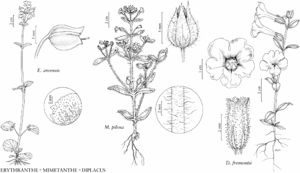Erythranthe arvensis
Phytoneuron 2012-39: 43. 2012.
Annuals, taprooted or fibrous-rooted, sometimes rooting at proximal cauline nodes if decumbent. Stems erect to decumbent-ascending, simple or branched from proximal to medial nodes, usually 4-angled, fistulose to very narrow, 5–70 cm, glabrous, sometimes minutely hirtellous in inflorescence, hairs deflexed, eglandular. Leaves basal and cauline or basal not persistent, often largest at mid stem or above, reduced in size distally; petiole 3–20(–90) mm, distals 0 mm; blade palmately 3–5-veined, ovate to orbicular, orbicular-ovate, oblong-ovate, or (middle and distal cauline) broadly orbicular to depressed-ovate or nearly reniform, (5–)10–35(–45) × 6–26(–50) mm, distal closely paired, auriculate-subclasping, base rounded to truncate, subcordate, or shallowly cordate, margins denticulate or subentire to distinctly dentate, on larger plants proximal characteristically lacerate-lobed to pinnatifid at margin base, apex rounded, surfaces glabrous except for bracts densely villous abaxially, sometimes also adaxially, hairs long, sometimes vitreous, flattened, eglandular, multicellular. Flowers plesiogamous, 3–8(–16), from remote distal nodes, chasmogamous or cleistogamous. Fruiting pedicels 5–40(–90) mm, longer than subtending leaves, glabrous. Fruiting calyces red-dotted or not, ovate-campanulate, inflated, sagittally compressed, (7–)9–14 mm, minutely hirtellous, throat closing or not, remaining open, lobes upcurving weakly, adaxial lobe not distinctly longer than abaxial, not falcate. Corollas yellow, usually red-spotted, weakly bilaterally or nearly radially symmetric, weakly bilabiate or nearly regular; tube-throat cylindric-funnelform, (7–)8–12 mm, exserted (0–)1–2(–3) mm beyond calyx margin; limb expanded 5–10 mm. Styles glabrous. Anthers included, glabrous. Capsules included, stipitate, (5–)6–7 mm. 2n = 28.
Phenology: Flowering Apr–Jun(–Jul).
Habitat: Hills, ridges, clay banks, stream banks, moist woods.
Elevation: 30–1900(–2300) m.
Distribution
B.C., Calif., Idaho, Mont., Nev., Oreg., Utah, Wash., Wyo., Mexico (Baja California).
Discussion
Erythranthe arvensis usually is easily recognized, characterized by its annual duration (but commonly rooting at proximal cauline nodes, suggestive of a rhizomatous habit), glabrous stems with nodes relatively few and remotely spaced, depressed-ovate leaves with margins often sublyrate (lacerate-lobed to subpinnatifid) at the base, distal leaves and bracts densely villous with vitreous eglandular hairs, other leaves glabrous, and corollas varying in size from relatively small but perhaps chasmogamous (the type of Mimulus arvensis) to even smaller (cleistogamous; the type of M. micranthus). The breeding system is consistently autogamous. The relatively short and even-sized calyx lobes that do not turn upward to close the orifice have been considered diagnostic of E. arvensis. This feature is evident in some plants, but others (perhaps reflecting gene flow from other species) have a longer adaxial calyx lobe and abaxial lobes that turn upward variably.
Selected References
None.
